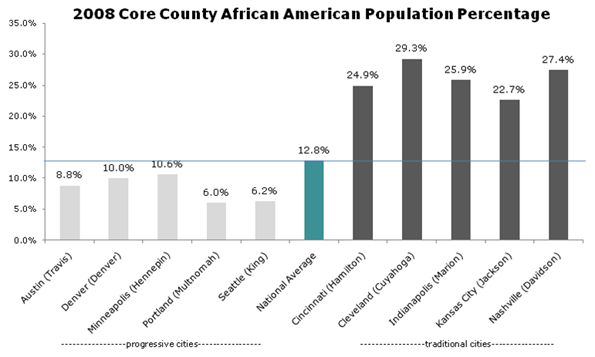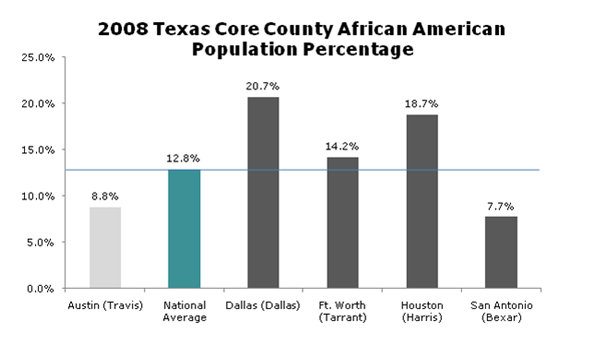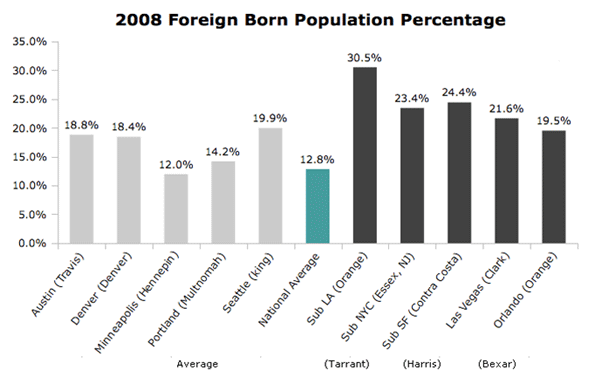
Among the media, academia and within planning circles, there’s a generally standing answer to the question of what cities are the best, the most progressive and best role models for small and mid-sized cities. The standard list includes Portland, Seattle, Austin, Minneapolis, and Denver. In particular, Portland is held up as a paradigm, with its urban growth boundary, extensive transit system, excellent cycling culture, and a pro-density policy. These cities are frequently contrasted with those of the Rust Belt and South, which are found wanting, often even by locals, as “cool” urban places.
But look closely at these exemplars and a curious fact emerges. If you take away the dominant Tier One cities like New York, Chicago and Los Angeles you will find that the “progressive” cities aren’t red or blue, but another color entirely: white.
In fact, not one of these “progressive” cities even reaches the national average for African American percentage population in its core county. Perhaps not progressiveness but whiteness is the defining characteristic of the group.

The progressive paragon of Portland is the whitest on the list, with an African American population less than half the national average. It is America's ultimate White City. The contrast with other, supposedly less advanced cities is stark.
It is not just a regional thing, either. Even look just within the state of Texas, where Austin is held up as a bastion of right thinking urbanism next to sprawlvilles like Dallas-Ft. Worth and Houston.

Again, we see that Austin is far whiter than either Dallas-Ft. Worth or Houston.
This raises troubling questions about these cities. Why is it that progressivism in smaller metros is so often associated with low numbers of African Americans? Can you have a progressive city properly so-called with only a disproportionate handful of African Americans in it? In addition, why has no one called these cities on it?
As the college educated flock to these progressive El Dorados, many factors are cited as reasons: transit systems, density, bike lanes, walkable communities, robust art and cultural scenes. But another way to look at it is simply as White Flight writ large. Why move to the suburbs of your stodgy Midwest city to escape African Americans and get criticized for it when you can move to Portland and actually be praised as progressive, urban and hip? Many of the policies of Portland are not that dissimilar from those of upscale suburbs in their effects. Urban growth boundaries and other mechanisms raise land prices and render housing less affordable exactly the same as large lot zoning and building codes that mandate brick and other expensive materials do. They both contribute to reducing housing affordability for historically disadvantaged communities. Just like the most exclusive suburbs.
This lack of racial diversity helps explain why urban boosters focus increasingly on international immigration as a diversity measure. Minneapolis, Portland and Austin do have more foreign born than African Americans, and do better than Rust Belt cities on that metric, but that's a low hurdle to jump. They lack the diversity of a Miami, Houston, Los Angeles or a host of other unheralded towns from the Texas border to Las Vegas and Orlando. They even have far fewer foreign born residents than many suburban counties of America's major cities.

The relative lack of diversity in places like Portland raises some tough questions the perennially PC urban boosters might not want to answer. For example, how can a city define itself as diverse or progressive while lacking in African Americans, the traditional sine qua non of diversity, and often in immigrants as well?
Imagine a large corporation with a workforce whose African American percentage far lagged its industry peers, sans any apparent concern, and without a credible action plan to remediate it. Would such a corporation be viewed as a progressive firm and employer? The answer is obvious. Yet the same situation in major cities yields a different answer. Curious.
In fact, lack of ethnic diversity may have much to do with what allows these places to be “progressive”. It's easy to have Scandinavian policies if you have Scandinavian demographics. Minneapolis-St. Paul, of course, is notable in its Scandinavian heritage; Seattle and Portland received much of their initial migrants from the northern tier of America, which has always been heavily Germanic and Scandinavian.
In comparison to the great cities of the Rust Belt, the Northeast, California and Texas, these cities have relatively homogenous populations. Lack of diversity in culture makes it far easier to implement “progressive” policies that cater to populations with similar values; much the same can be seen in such celebrated urban model cultures in the Netherlands and Scandinavia. Their relative wealth also leads to a natural adoption of the default strategy of the upscale suburb: the nicest stuff for the people with the most money. It is much more difficult when you have more racially and economically diverse populations with different needs, interests, and desires to reconcile.
In contrast, the starker part of racial history in America has been one of the defining elements of the history of the cities of the Northeast, Midwest, and South. Slavery and Jim Crow led to the Great Migration to the industrial North, which broke the old ethnic machine urban consensus there. Civil rights struggles, fair housing, affirmative action, school integration and busing, riots, red lining, block busting, public housing, the emergence of black political leaders – especially mayors – prompted white flight and the associated disinvestment, leading to the decline of urban schools and neighborhoods.
There's a long, depressing history here.
In Texas, California, and south Florida a somewhat similar, if less stark, pattern has occurred with largely Latino immigration. This can be seen in the evolution of Miami, Los Angeles, and increasingly Houston, San Antonio and Dallas. Just like African-Americans, Latino immigrants also are disproportionately poor and often have different site priorities and sensibilities than upscale whites.
This may explain why most of the smaller cities of the Midwest and South have not proven amenable to replicating the policies of Portland. Most Midwest advocates of, for example, rail transit, have tried to simply transplant the Portland solution to their city without thinking about the local context in terms of system goals and design, and how to sell it. Civic leaders in city after city duly make their pilgrimage to Denver or Portland to check out shiny new transit systems, but the resulting videos of smiling yuppies and happy hipsters are not likely to impress anyone over at the local NAACP or in the barrios.
We are seeing this script played out in Cincinnati presently, where an odd coalition of African Americans and anti-tax Republicans has formed to try to stop a streetcar system. Streetcar advocates imported Portland's solution and arguments to Cincinnati without thinking hard enough to make the case for how it would benefit the whole community.
That's not to let these other cities off the hook. Most of them have let their urban cores decay. Almost without exception, they have done nothing to engage with their African American populations. If people really believe what they say about diversity being a source of strength, why not act like it? I believe that cities that start taking their African American and other minority communities seriously, seeing them as a pillar of civic growth, will reap big dividends and distinguish themselves in the marketplace.
This trail has been blazed not by the “progressive” paragons but by places like Atlanta, Dallas and Houston. Atlanta, long known as one of America's premier African American cities, has boomed to become the capital of the New South. It should come as no surprise that good for African Americans has meant good for whites too. Similarly, Houston took in tens of thousands of mostly poor and overwhelmingly African American refugees from Hurricane Katrina. Houston, a booming metro and emerging world city, rolled out the welcome mat for them – and for Latinos, Asians and other newcomers. They see these people as possessing talent worth having.
This history and resulting political dynamic could not be more different from what happened in Portland and its “progressive” brethren. These cities have never been black, and may never be predominately Latino. Perhaps they cannot be blamed for this but they certainly should not be self-congratulatory about it or feel superior about the urban policies a lack of diversity has enabled.
Aaron M. Renn is an independent writer on urban affairs based in the Midwest. His writings appear at The Urbanophile.













Philadelphia
I live in Philadelphia, and on a visit to Portland, Oregon I kept asking my friends who lived there,"Where are all the black people?" I thought I was visiting a city, and to me, that means lots of different kinds of people.
Philadelphia is a completely different kind of city and I think (and hope) Philadelphia bucks some of the trends in your article. There are people from many backgrounds living here and the progressive white hipsters do an o.k. job of coexisting and even partnering with local communities.
I still can't put my finger on what it is about Philly that makes it so uniquely appealing? I think it might be worth another article in itself.
What's so great about diversity anyway?
The author of the article seems to just assume that "diversity" is a goal we should want all our cities acheive without much explanation why. So Britt, since you seem so clear that living in a diverse city is preferable to living in a less-diverse one, perhaps you can explain it to the rest of us. And while you're at it, perhaps you could tell us what's wrong with people choosing to live in less diverse areas if they want to.
Another thought: I think open-minded whites should read this article and ask themselves whose agenda is being served here. White people in these white cities like Portland, Austin, Seattle, etc. should be proud of what they've built - and if being a good "progressive" means to step aside and watch what you've built be torn down in the name of "diversity," then perhaps the problem isn't with being too white, it's with being "progressive."
Really?????
"I live in Philadelphia, and on a visit to Portland, Oregon I kept asking my friends who lived there,"Where are all the black people?" I thought I was visiting a city, and to me, that means lots of different kinds of people."
City means different kinds of people? How do you define different. Go to Tokyo or Shanghai. Are they all the same? How about Vienna? All the same?
Surface appearances do not define differences or diversity. Diversity and difference can be in height, weight, political views, social approach, communicaiton, intelligence.
We need to challenge ouselves to look beyond 'how many black people can you count and if the number is big than that's good'.
HUGE flaw in the methodolgy:
From the article: "Can you have a progressive city properly so-called with only a disproportionate handful of African Americans in it?"
I hate to break this to you, but obviously you missed a memo or something. African Americans are no longer the largest minority population in the US... Hispanics are.
If you look at the demographics for Portland:
http://www.helloportland.com/Census.Cfm
(2000 Census data)
The city is 77.9% white. That's just 3.9% above the national average. So where is the diversity coming from?
Among those identifying with a single race:
77.9% White
6.8% Hispanic
6.6% Black (I say "Black" rather than African American as Portland has significant populations of actual African blacks.)
6.3% Asian
4.1% multi-racial
3.5% Other
In your article you're assuming non-Black = non-diverse and that's actually a pretty racist assumption in and of itself. Even among the white population in Portland there's diversity due to large numbers of Poles, Russians and Croatians, they have their own language, their own culture, heck their own marketplaces. It's all part of what makes Portland interesting.
78% white = white city
I like how you cite statistics that show Portland is 78% white and then argue the author has a HUGE flaw in his methodology! Wow only 78% white? Sounds really diverse!
Many commenter's take issue with the article's focus on blacks. The fact is black populations have always been the hardest for white cities to integrate. After all Hispanics share much of same ancestry as "whites", and Asians share many of the same values. On most measures of success Asians are actually superior to whites, so citing a large Asian population actually supports the main point of the article! In case you missed it, the point is: Your "hip" progressive city is only possible because it lacks poor disenfranchised minorities! Saying "but hey we have rich enfranchised minorities!" hardly helps.
Personally, I see nothing wrong with people congregating according to their own preferences. That is what freedom means. My white/Asian suburban college-town neighborhood is so perfectly engineered it looks like a screenshot of a city planner's computer screen, and I couldn't be happier. I'm on the other end of the white spectrum from the Portland hipsters. I can't understand their urban romance or complaints about "suburban sprawl" and "car culture". When did having room to breathe become un-cool? Why would I want to be surrounded by concrete and arrive to work sweaty from biking every day?
I would hazard a guess that the 4000 sq ft X-urban McMansion, in ground pool, home theater, etc. , 3 car garage, 2 acre plot, commute via car lifestyle is preferable to every other realistic lifestyle alternative for 90% of people of ALL racial groups, and you don't need to move to Portland to enjoy this. In fact, the hipster crowd there actively opposes the easy wealthy lifestyle that most disadvantaged minorities long for.
interesting article
I think its useful to think about American cities more in terms of economically segregation than racial segregation. Obviously our racial history has lead to a lot (most) of the economic disparities between races.
It shouldn't be any surprise that the wealthiest neighborhoods and city districts are the ones that support lavish streetscape improvements like streetcars and bike lanes, have dense infill development, and otherwise "progressive" planning programs consistent the robust economic environment they operate in. As you said:
"relative wealth also leads to a natural adoption of the default strategy of the upscale suburb: the nicest stuff for the people with the most money."
Washington, DC is a great example of a city whose economic emergence is paired with a proliferation of great pedestrian improvements strewn across the city. Yes, much of these improvement are happening in wealthy areas or areas primed for investment. But plenty of money is being funneled into DC's disadvantaged communities including a streetcar in one of the city's poorest neighborhoods and safe, timed crosswalks which have become standard across the city. Definitely the streetcar was viewed with some suspicion in Anacostia, but many have embraced it as opportunity to increase mobility and access to employment to the city's underprivileged, and yes, minority communities.
what's wrong with that?
This paragraph really stuck with me:
"In comparison to the great cities of the Rust Belt, the Northeast, California and Texas, these cities have relatively homogenous populations. Lack of diversity in culture makes it far easier to implement “progressive” policies that cater to populations with similar values; much the same can be seen in such celebrated urban model cultures in the Netherlands and Scandinavia. Their relative wealth also leads to a natural adoption of the default strategy of the upscale suburb: the nicest stuff for the people with the most money. It is much more difficult when you have more racially and economically diverse populations with different needs, interests, and desires to reconcile."
We have to release ourselves from the guilt that historically disadvantaged groups need to be propped up somehow. This article doesn't offer a solution, only points out what the author considers to be a problem: "too many of them, not enough of us" in certain cities that are being heralded as nice places to live. Couple of points there, then:
1. it goes to show the lie that is typical liberalism. White people who cycle, buy green light bulbs, and talk big about Obama are the same ones who see no problem living in cities like these even despite the information in this article - the NIMBY crowd. Yuppies and urbanites have not changed in the last 30 years.
2. the "escape to the suburb" idea went out of fashion in the 1970s. Many cities at that time had more segmented populations - one extreme example is Boston. The whites that "fled" to the suburbs; this was simply a product of Irish and Italian immigrants being successful enough to afford bigger apartments, another car, and more land than within the city limits of Boston, and so they decided to move out. Many stayed behind, too, but we don't hear much about that I guess. They weren't escaping blacks or any other group. A generation later, these populations are now spread out, and the kids who grew up in the suburbs know nothing else. They see the city though, and then think about what they know (the suburbs), and ultimately that's what they want, a quiet suburb - because they grew up in a time of prosperity where our fathers and mothers grew up during times that were a bit more rough.
3. what is wrong with wanting to live with people like you , per the above quoted paragraph? Nothing, really - it's hardwired into our DNA , in fact, and the idea of multiculturalism appears to have run its course. We tried many ways to integrate populations, and what has been the result? First we had the "whites fleeing to the suburbs" idea, which is actually a fallacy, now we have the white enclaves of gated communities for wealthy looking to escape poorer areas (not necessarily less diverse areas).
You can't force-fit material equality in society; that's called communism and it doesn't work. You also can't force socio-economic equality because: A: people like to live and work with others like them, and this isn't racist, it's simply natural; B: some people are more capable than others, whatever their race, and some groups of people generally speaking have different capabilities than others. So, a city filled with blacks and built on values shared by blacks would look a lot different than a Minneapolis-St. Paul, built traditionally on Scandinavian values, per the article. No one is saying it would be better or worse: it would be better for blacks, not so great for "whites" (which isn't really a group but a broad generalizaion in itself) who wouldn't fit into that set of values.
I think the solution is, encourage people to work together in groups they feel comfortable with, ensure that everyone's rights are protected under the Constitution, and let the federal government otherwise sit back and see what happens. You'd likely find people gravitating toward people who are like them - not just visibly but culturally. Isn't this the best way to celebrate diversity, by allowing diverse cultures to flourish on their own with a basic set of rules in place (life, liberty, etc.)?
Similar flight within cities
You see a similar 'flight pattern' within cities, and it's similarly unremarked upon. For example, consider the trendier neighborhoods of Brooklyn. In a post earlier this year ("Lessons from Brooklyn's New Economy"), I included a group photo of eleven entrepreneurs from a New York Times article about Brooklyn's burgeoning new culinary movement and noted sarcastically that photo gave one a sense of the sort of ethnic diversity one finds in NYC's trendier neighborhoods.
Dubious numbers
Why is it that progressivism in smaller metros is so often associated with low numbers of African Americans?
Actually, they aren't, your numbers are just skewed.
Comparing the demographics of those 5 cities with the demographics of the states they are in (and other cities in the state) tells a very different story. Every one of them is less white and more diverse compared to the state as a whole and other cities in the same state, so yeah, they do have cause to feel self-congratulatory.
The exception is Austin which has the same proportion of African Americans as Texas does, but much less than other cities in Texas. Do minorities prefer Dallas to Austin because they hate adequate public transit and walkable neighborhoods? Maybe, but it seems very unlikely considering the greater diversity in other role model cities pursuing the same policies.
RE: Dubious numbers
"Do minorities prefer Dallas to Austin because they hate adequate public transit and walkable neighborhoods?"
Um, probably not, since DART puts Capital Metro to shame.
http://www.dart.org/maps/printrailmap.asp